USER REPORT: OMD E-M5 and Panasonic 12-35mm in Cambodia and Vietnam by Richard Nugent
I recently returned from a trip to Cambodia and Vietnam where I had the chance to really give my OMD E-M5 and Panasonic 12-35mm zoom a workout. I have had the camera for less than a year, having down-sized from a Nikon D300 and D5100. However, I had not had the chance to use it extensively until this trip. So it was a learning experience for me that I thought some of your readers might also find worthwhile.
We started at Siem Reap touring the Angkor archaeological sites and then took a cruise down the Mekong River into Vietnam, stopping at villages, marketplaces, schools and temples along the way, ending up in Saigon. The lighting conditions throughout were challenging: very bright sun and deep shade, with many hazy-bright days thrown in. I shot almost everything in aperture priority with automatic white balance and set the ISO myself. I found that I often had to use the exposure compensation dial (which is perfectly located up front), probably mostly because of my inexperience with the camera. Battery life was less than with my Nikons: I had to change out about mid-day, but still easily got by with two batteries each day. I brought three batteries on the trip: one charged overnight and one charged during the day while I was in the field with the other two. . The electric current in both countries is 220 volts, but the outlets in the hotels and on the boat all accepted standard US-style plugs. So I didn’t need an adapter.
I shot hand-held although I brought along a monopod. Moving with a group through the ruins and villages just did not lend itself to using it. Likewise, I stuck with the zoom and didn’t use my prime lenses much because the pace of moving through the ruins with a guide (while trying to get a shot without tourists in it!) made changing lenses problematic. In the villages, I felt very intrusive and shot as quickly as I could. I have to say that I found the Vietnamese and, particularly, the Cambodians incredibly polite, friendly and tolerant of groups of foreigners traipsing through their villages snapping photos of them, their children and their homes. No one was looking for a hand-out, but some (particularly the children) were eager to see their image on my LCD after I took the shot. They are amazing people making a life for themselves under challenging circumstances. By the way, I found that flipping out the LCD and shooting from the waist was very effective in getting to eye level with children and seated adults. It also appeared to be less intimidating for the subjects.
12 to 35mm was a good range for the village and people photos, but a wider lens would have been very useful for capturing the interior of the temples and their exterior extent. I used an Olympus 40-150mm for shots from the boat; it’s a great little lens and quite sharp, even hand-held. In a few instances, I could have used a longer lens.
The 12-35mm yielded some really good images, some of the best I’ve taken (I find I do best with people). There is obvious edge distortion at the wide end (more than I remember with my Tokina 12-24mm) and chromatic aberration is evident in some shots. Overall, I’m very pleased with the color rendition and sharpness of the lens. It is a bit bulky on the OMD, but it gives me a familiar feel and heft reminiscent of my DSRLs.
I processed my RAW files with Lightroom 4, which I am just starting to learn, so I probably fiddled with the sliders more than necessary. I tweaked the shadows and highlights on most images and was able to save a number of badly exposed ones that way. The OMD’s automatic white balance was almost always spot-on, so I rarely had to adjust it. I did have to tinker with the luminescence in some images shot at about ISO 640 and above (in-camera noise reduction and sharpening were set to “off” or “low”). When I get more proficient with LR, I’ll have to go back and see if I can get even more out of the data.
I’ve attached a few of my favorite images. If anyone is interested, they can see a photo chronicle of the trip at http://www.flickr.com/photos/rsnugent/sets/72157632700316808/. The set includes both good shots and just ordinary ones, but they will give the viewer a sense of the experience. I highly recommend the trip, both for the photographic opportunities and the cultural interaction.
Cheers,
Richard Nugent
P.S. Steve, I find your site very useful and informative. It’s one that I check every day!
Image Data: Monks: 1/400, f/4.0, ISO 400. Four Girls: 1/1000, f/4.0, ISO 400. Old Woman: 1/4000, f/5.0, ISO 640. Four Kids: 1/640, f/5.0, ISO 800. Temple: 1/10, f/4.5, ISO 800 (I know you said only three photos, but I couldn’t decide….)

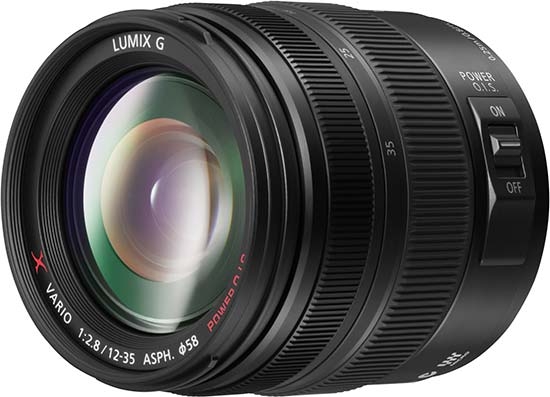
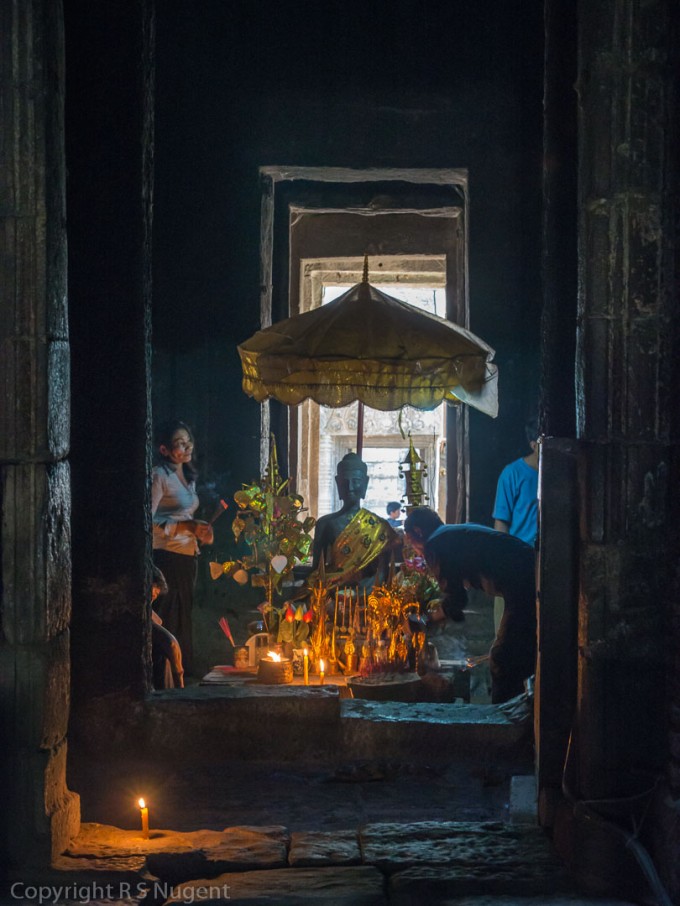
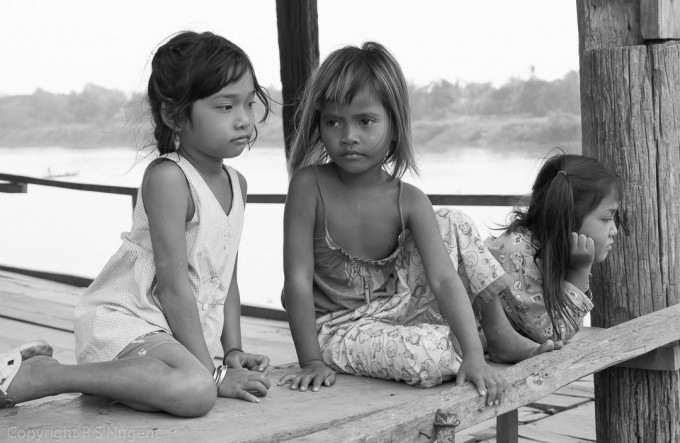
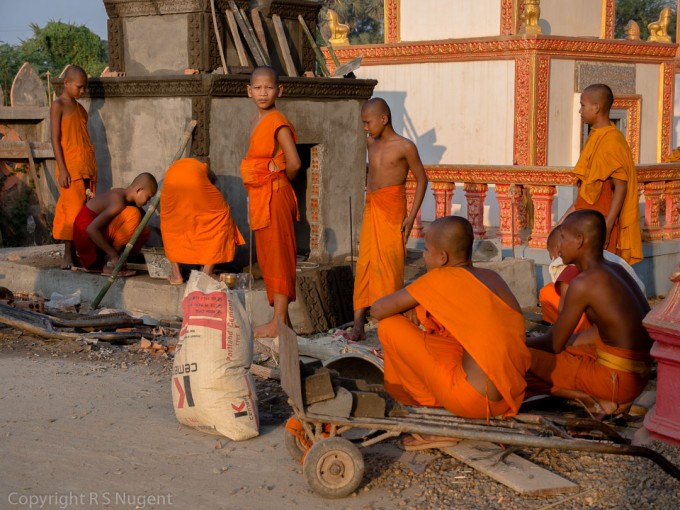
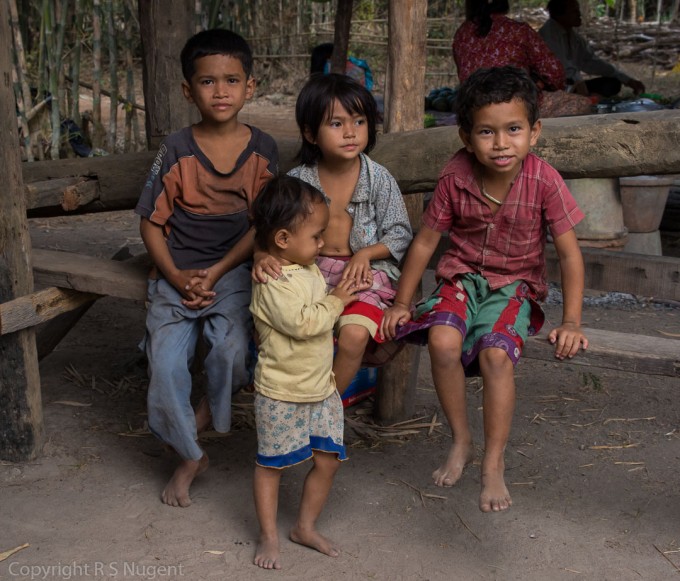
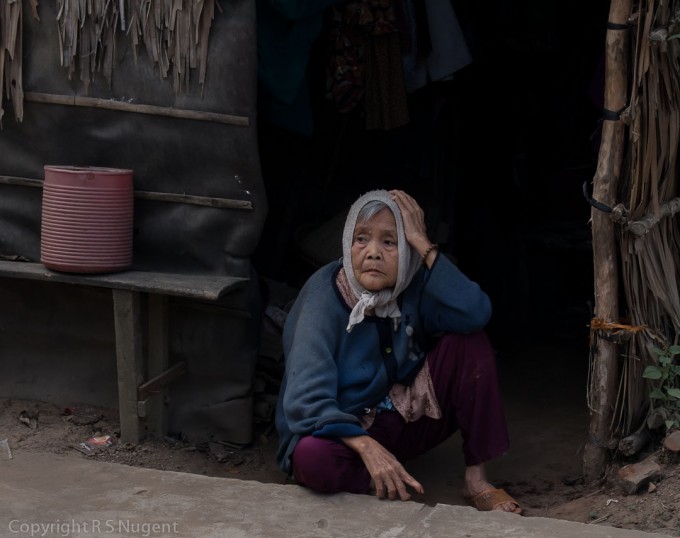



A very nice review of the OMD-EM5 Richard. I have owned the EM5 since it was released and have used it extensively on international trips, recently to Tahiti and Guatemala. On these and other recent trips I opted to take the EM5 and a recently purchased EM10 leaving the Nikon gear at home. Your report and photos were just what I needed to reinvigorate my enthusiasm for the EM5.
I enjoied the Interior-of-Bayon-Temple picture for it’s composition and light.
The photo of the children on the dock is precious. Simply wonderful
The photos of Vietnam are wonderful. It must have been a fabulous trip..thanks for sharing.
Fantastic photos. Did you miss anything from your D300 either in image quality or handling? What did you feel like you gained over your D300? Thanks for sharing your experience.
Thank you, S. The biggest difference was, of course, size and weight: the OMD kit was much lighter & smaller. This smaller size may have been less intimidating to those people I photographed, but that was hard to really evaluate. Overall handling was similar, but the D300 was more complex. The OMD super control panel was a definite plus when I had to change settings. The top LCD on the D300 was useful in checking most settings, but the same info was available on the back LCD of the OMD.
I personally did not see much difference in IQ. But remember, I frequently shoot hand-held and I do not pixel-peep. I have been able to get good sharpness from both cameras and have blurred some with both as well. As far as color rendition and color depth, both cameras seem to be about equal. But I have not done any side-by-side comparisons (and the subject matter for the OMD is different so far from what I shot with the D300).
My overall observations would be that for casual shooting (travel, family, etc) the IQ would be pretty much indistinguishable (unless you will be doing BIG enlargements). For more complex shooting the D300 offers more specialty settings and is more rugged and weather-proofed (Nikon considers it to be the “pro” DX model). But it is a bigger and heavier camera and the lenses are bigger as well. For travel or hiking the OMD is much more convenient.
Hope this helps. Cheers.
Richard. Thanks for sharing good pictures and a sensitive text. I also use OMD-E5 more and more because of the weight (I am not getting younger). I have a question as a public health physician living in South Asia: I am intrigued by the hair color of the girl on picture 2. Because it is B&W I could not figure out. Were there streaks of reddish? If yes this would probably be a sign of malnutrition. Thanks again
Pierre, Yes, the streaks were yellowish-brownish-red. She did not appear to be malnourished. I will post the color version of the image on my Flickr page (link is in the essay above..it will be the last photo in the series). I did notice a few children with the same hair coloration (rather than uniformly dark) at several other locations as well, and wondered about it as reflecting genetic background. I did not consider that it might be a nutrition issue.
She and her two friends were at the “dock” on the river bank where our boat tied up, which was about one mile from the village of Kampong Tralach, Cambodia. We visited a school there (which the tour company has adopted), so these girls were not in class, which may reflect their economic level and hence their risk of under-nourishment.
I admire your dedication to these wonderful people. Cheers.
Beautiful pictures. Sounds like you didn’t have to do much post-processing.
Also, have you used the old Olympus 14-55mm 2.8-3.5 lens? I loved the color from that lens and wondered how this new Panasonic compared to it.
Thanks for the compliment, S. No I have not used the Oly 14-55 lens.
Nice photographs. Thank you for sharing with us.
GRJ
Great shots, thank you for sharing!
Hi Richard,
Some great shots and a nice post. I shoot the OM-D as well. It is a great camera. I never shot using a DSLR (only an old Minolta SLR for film). Coming from a DSLR, do you see noise at even base ISO an issue with the OMD? Particularly in the shadows. For example with your first temple shot.
Cheers,
Mo
I find that with the E-M5 you need to over expose the shot is these situations. So lets say it’s sunny with a few clouds above, well you take the metering of whatever is on the ground. This will make the sky look white and you would think it not to be recoverable. You would be wrong!
It’s amazing how much you can recover from the highlights, not so with the shadows. Mind you the E-M5 is better than my 7D with shadow recovery, but it gets noisy if pushed too far.
Maybe Richard can shed some light on how he exposed for that photograph.
Mo, I do not see noise until I get to about ISO 640 or above. If I badly under-expose an image at lower ISOs I sometimes get noise when I try to recover the shadow detail. Most of the time I can minimize the noise in Lightroom, but with a loss of some detail.
The data for the temple image are: f/4.5; 1/10; ISO 800 and Exposure compensation -0.3; focal length was 35mm. I used the Pattern exposure mode. The original was shot in RAW. The resulting image was very under-exposed and the doorway behind was almost completely blown out. Yet Lightroom allowed me to salvage the image, but with the cost of a lot of shadow noise.
I have posted the out-of-camera image before processing on my Flickr page under the link in the essay above. You can see where I started. This will give you an idea of whether the remaining noise in the image is worthwhile.
Thanks for your interest. And thanks to Nawaf as well.
I found the last two pictures. especially the last, to be beautifully affecting. I glanced at these pics on my phone while commuting and then later had to return to that woman, squatting, thoughtful and tired, by the door. A very nicely communicated piece, with lovely work. Thank you for submitting, and thanks Steve for posting.
Thanks for the compliment, Jack. The elderly woman just squatted silently in her doorway as my group passed. I was not comfortable stopping to take her picture, so I moved away and shot from a distance. In almost all cases, I asked the subject (with sign language) if I could photograph them before doing so. With her, I took the liberty of shooting from afar because I did not want to interrupt her thoughts. I was able to photograph a number of other adults and children in both Cambodia and Vietnam, some of them are included in my Flickr album. It was a very rich environment for people shots. In almost all cases, the OMD gave me really rich colors.
I love your pictures of the little girls (they look so sad I just want to buy them some ice cream to put a smile on their face), and the Monks. I understand your uneasiness of shooting folks that have so little in their life and we have so much. I’m challenged as a tourist with stealing the images without a real reason for doing so. If I’m going to use the images to help them elevate their circumstance that is one thing otherwise I’m comfortable with just shooting typical scenic shots. I’m torn with this whole people and street photography thing. It seems such a great invasion of one’s privacy over the notion of art and creativity.. Good work.
Howard
Great photos and write up Richard!
Thank you, A.
Wow Richard, I like your photos and I like your writing style even more, do you have a blog somewhere?
I also have traveled to Vietnam from China, but I broke my leg there from a motorcycle accident but the people in the village as well as doctors were extremely friendly and helpful, your photos remind me of the great days I spent there.
Thank you for the compliment, Z.Y. I do not have a blog (mainly because I am not sure that I have that much to say!). Let me return the compliment and say that your English is excellent. That is quite an accomplishment! I’ll bet that your talent as a photographer is equally outstanding. Cheers.
Richard, excellent shots. The color is especially good. I am also using an E-M5 and Lumix 14-35 and I am very pleased with the result. You might consider the Lumix 7-14 zoom to get the wide angle shots. It is sharp and rugged but pricey. I have visited the same areas in Asia but from Angkor Wat we went west to Thailand and Myanmar instead of east to Vietnam. My experience with the poverty was a little different than some of the other comments here. I have seen two kinds of poverty. One is the kind of crushing, hopeless, dismal existence of people who live in the street and makeshift homes and scavenge garbage dumps all day for anything to eat or use that is common in Mexico, for instance. In Asia I found a healthy and well developed culture and communities that simply lacked material wealth. Myanmar, for example, is classified as one of the poorest in the region but everywhere we visited, including some rural villages, the people appeared well fed and clothed living in well constructed villages as families. Their houses were bamboo but sturdy with nice areas to eat and relax. Several generations of the same family were usually present. They had to bathe in a stream but they bathed. TVs could be seen in most of the houses. It is a society that has just not advanced much since the British left. I’m sure they experience the same kinds of stresses and conflicts as all people living together but they seemed otherwise content, not in constant pain and despair. Cambodia was the worst we saw but it is becoming healthy and thriving as it emerges from a nightmare westerners cannot imagine. The worst part of the trips were the kids who had learned to beg at tourist stops in Cambodia, the scammers who try to con individual tourists in Bangkok, and Japanese tour groups, which are a plague that ruins the experience for everyone else everywhere they go.
Thanks, George. We did not encounter any grinding poverty in our stops. The people in the villages live simple lives and appeared content. Those in Vietnam were a bit better off and were more upward striving. I agree that most of us in this country frequently get caught up in the unimportant things and fail to recognize how well off we as a people are. Travel to developing countries gives one a reality check…
An illustration of what photography can be. Photos of things,people and places most of us will never have an opprotunity to experience. While I enjoy this site I really tire of the pixel peeping and the Leica look and the Nikon look etc. I just enjoy well taken photos without all the the other hype. Sure equipment make a difference – if the person using the product can master the device, but ultimately what is behind the camera is the real difference. The entire photos series provided in the link was very enjoyable. Thanks Richard
You are welcome, Martin. Thanks for looking.
Agreed…what a great set of pics. The pictures really took me there. Peace.
Enjoyed your images here and flicker, having returned from area 3 months ago. I am a fan of smaller more manageable cameras, too. The last photo here of the woman is amazing. The people age rapidly due to their harsh life but remain dignified.
Thanks for looking, Stanford.
These are fine images, and I also own the OM-D…. but the problem I see with using 12-35/F2.8 is that you just don’t get much separation of the object because it is an effective F/5.6 DOF in full-frame terms. So essentially you are paying $1100 for an effective 24-70 F/5.6 lens again I am talking in terms of Depth of Field. The small sensor of OM-D just does not help. I think even F/1.8 is a border line on m43 (F/3.5 equivalent) and that both Panasonic and Olympus need to design more F/1-1.4 lenses. Since they have to cover a much smaller circle, these don’t have to be extremely large and heavy lenses. I hope the Olympus rumored normal zoom is F/2.0 and not a F/2.8. I do like 45/1.8 and 75/1.8 and use them on OM-D, but even with these I feel that Olympus could have designed something faster.
I agree David. I sorely miss the ability to isolate a subject with DOF. In my many years with film SLRs, I always shot aperture-priority precisely for that reason. It’s been a challenge with crop-sensor DSRLs, even with “fast” primes. I’d like to try a full-frame DSRL but I’ve decided to downsize, so going back is not likely. thanks for your comment.
I’m not so sure. Henri Cartier-Bresson used to refer to f 5.6 (full frame) lenses as shallow DOF. That is effectively the same DOF of the Panasonic lens. This emphasis on razor thin DOF is silly. While the shallow DOF isolates a subject, it detracts from the story told by the rest of the picture. The subject is part of a larger frame i.e. some selective focus helps direct the attention while keeping the subject in the overall context of the frame. You can certainly get enough of that at f 2.8 on the 12-35. Moreover, unlike many Canikons, these are actually good performers wide open.
Well, first of all, did F/5.6 lenses cost $1100 in the times Cartier-Bresson was active?
And I do agree that SOMETIMES shallow DOF detracts for the story told, but MORE OFTEN THAN NOT shallow DOF makes the photo. So such emphasis is far from what you describe is silly. And if you have a fast lens with thin DOF, you can always stop it down and ‘tell the story” as you indicate. However, with a slow lens, you can’t go the other way around, can you? It is good to be able to do both, right?
The nature of m43 lenses is that they have to cover quite a small circle so it is easier to make lenses that are sharp wide open, not much glass is needed. And to make them small too.
But it is much easier from marketing standpoint, to make a lens that consumer just sees F/2.8 and thinks he is getting a 24-70 F/2.8 equivalent and sure, paying $1200 for a 24-70 F/2.8 equivalent does not sound as bad, right, as Canon 24-70L II that I also own costs $2000 and Nikon 24-70 costs about the same. But how does it feel to pay $1200 for 24-70 F/5.6 lens???? Nikon’s 24-85 F/3.5-4.5 IS you can pick up for less than $400 these days.
The bottom line of my rant above is that this lens should have been much cheaper with what you are getting I am just feel we are being cheated there. That’s all.
They probably cost more in real terms, given his time was well over half a century ago.
Dave B. I see this statement in many places and while I think I understand what is meant I also think it may be wrong. I am not an accomplished photographer but have read quite a bit to learn what I can.
These are fine images, and I also own the OM-D…. but the problem I see with using 12-35/F2.8 is that you just don’t get much separation of the object because it is an effective F/5.6 DOF in full-frame terms.
Separation of objects in a frame is not accomplished by aperture but but focal length. Shorter focal length lenses tend to separate items in a frame and longer focal length lenses compress items in a frame. Aperture can make the background out-of-focus but I do not think that is separation.
I would thankful if someone can confirm or correct my thoughts.
GRJ, to get an illustration, see this page from dpreview’s review of Fuji X10 camera. They are comparing F/2.8 on it with F/2.8 on Full frame and F/2.8 on 1.5 crop, with illustration to see why you never going to be able to get the same effect on a smaller sensor with same aperture: scroll about 1/3 page down http://www.dpreview.com/reviews/fujifilm-x10/8
So you need 3000$ gear to make good pictures…………………….
Small DOF is not the only way to have good portrait, and the DOF with 35mm 2.8 on m4/3 is smaller enough to get a blurry background.
David B,
Thanks for the link. I can clearly see the difference in the background clarity/blurriness between the X10 and the D4.
However, it is equally clear separation(distance between) of the objects(man and bush) is the same for the X10 and the D4. Sensor size has no impact on separation. It does have an impact on background blurriness.
Focal length impacts the perceived distance between the objects in the frame. If dpreview would take the same pictures(fill the same amount of frame with the man) with a 28mm(closer to the man) lens and an 85mm lens (farther from the man) the images would be quite different not because of blurriness but because the bush would appear farther behind the man in the 28mm image than the 85mm lens.
I think.
I do not own a camera at this time. Perhaps someone can do this exercise and post the results.
Thanks for the discussion.
GRJ
Your thoughts are quite correct and I can confirm them. 😉
I will add that shallow depth of field is often most effective with a longer focal length, because the combination of compression and soft out-of-focus background elements makes for a pleasing result.
If using a wide lens that reveals much more of a scene, a thoroughly blurred background can actually be more of an annoyance, because our eye just naturally wants to take in more of the “story.”
If one is, indeed, storytelling, there’s a bit of cinematic knowledge that comes in to play when considering all of this.
Thanks for sharing Rich!!!
The OM-D E-M5 is sick gear if not for the Sony DSC RX1 and well (a bit tongue-in-cheek) the Leica M9/M type 240 and the available M glass. Certainly, your pics are a testament of the power and flexibility of the OM-D E-M5!!!
I too have been to SE Asia and the poverty is sickening and I agree whole heatedly that these people have a remarkable spirit and heart, despite the dearth of nearly any of life’s conveniences. Makes you really put into perspective when we here argue about whether a $1K camera can compare to a $7K camera … the villages I visited in certain places in SE Asia, the children didn’t even know what ice cream tasted like … these people will in all likelihood will not ever accumulate $7K in their lifetimes.
Cheers.
Thanks for looking, MB. Almost everyone could use a visit to a developing country to put their own life in perspective.